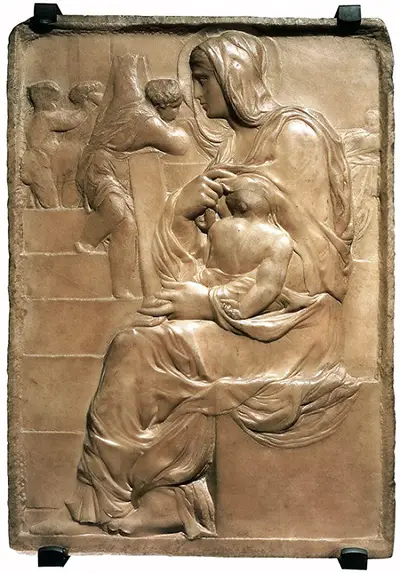It is believed that the marble sculpture was finished around 1491. The iconic sculpture stands at 22.3 inches tall and is 15.8 inches wide.
Today the Madonna of the Stairs, can be viewed at the Casa Buonarroti in Florence, Italy. The sculpture which is also referred to as the Madonna of the Steps, was created when Michelangelo was just seventeen years of age, and it was one of his very early sculptures, alongside that of Battle of the Centaurs.
Art critics and historians alike believe that Madonna of the Stairs was an artistic tribute towards the great works of Donatello, and especially his famous Vasari. This was in terms of the technique used, thickness of the material and scale of the steps.
The sculpture also drew inspiration from the book, Ladder of Paradise.Michelangelo's sculpture that at first sight appears as a large and waxy slab of marble, demonstrates stelai techniques that are derived from the Greeks. The detailing to the Madonna and the child are incredibly intricate, with the chisel being used as a pencil rather than a cumbersome tool.
What we observe when we look at the sculpture is the Madonna sat on a square slab, right at the very foreground, taking up most of the image. Her profile is sculptured in the classic manner of the day.
Interestingly, we cannot see the Christ child's face, as they are turned away from the observer, hidden amongst the Madonna's clothing. We are unsure as to whether the child is sleeping, or nursing.
What is clearly shown is the Madonna protecting the child in a soft and enclosing embrace. Her pose is natural, she is seated with her legs crossed and we can clearly see that her long robes have become entwined and twisted around her right leg.
This is somewhat of a trademark for Michelangelo, and can be seen in many of his later sculptures. Surprisingly, the frame of the sculpture is unfinished, as is the Madonna's halo, which carries on past the confines of the sculpture. This is entirely deliberate, as it helps to blend the lines between art and reality, creating a sense of space.
Michelangelo has also broken with tradition in he carving of this sculpture. In most artistic interpretations of the Madonna with child, she gazes adoringly at the infant. However, in Madonna of the Stairs, he has chosen to sculpt the Madonna looking away from the child, almost into the middle distance.
As an observer though, we still feel the love between them, and the strong bond, by the way in which she is cradling the child in a protective embrace. As her gaze is not upon the child, so too does our gaze wander across the entire image. We see the mischievous figures in the background, whom art critics believe were sculpted in homage to Michelangelo’s own siblings. These four figures hold a long piece of cloth, which most probably represents Christ's shroud.
Many art historians have called into question if this was indeed one of Michelangelo's early works. It would appear though that the dating of this sculpture is indeed correct. When we closely observe the Christ child we note that he has been sculpted in a rather muscular manner, in very much the same way that Michelangelo went on to sculpt men in his later works. The arms and legs of the figures in the background, also seem to have been sculpted out of proportion, indicating that this was indeed an early work by the great Italian Master.
This iconic work is still shrouded in mystery today. Why paint the Christ child looking away from the observer? What do the stairs represent? Why is the Madonna looking so impassively at the observer? Only Michelangelo knows the answers to these questions. But, what he sculpted on a small scale, was a magnificent and wonderful image of the Madonna with child, that will be observed and questioned for many more centuries.


